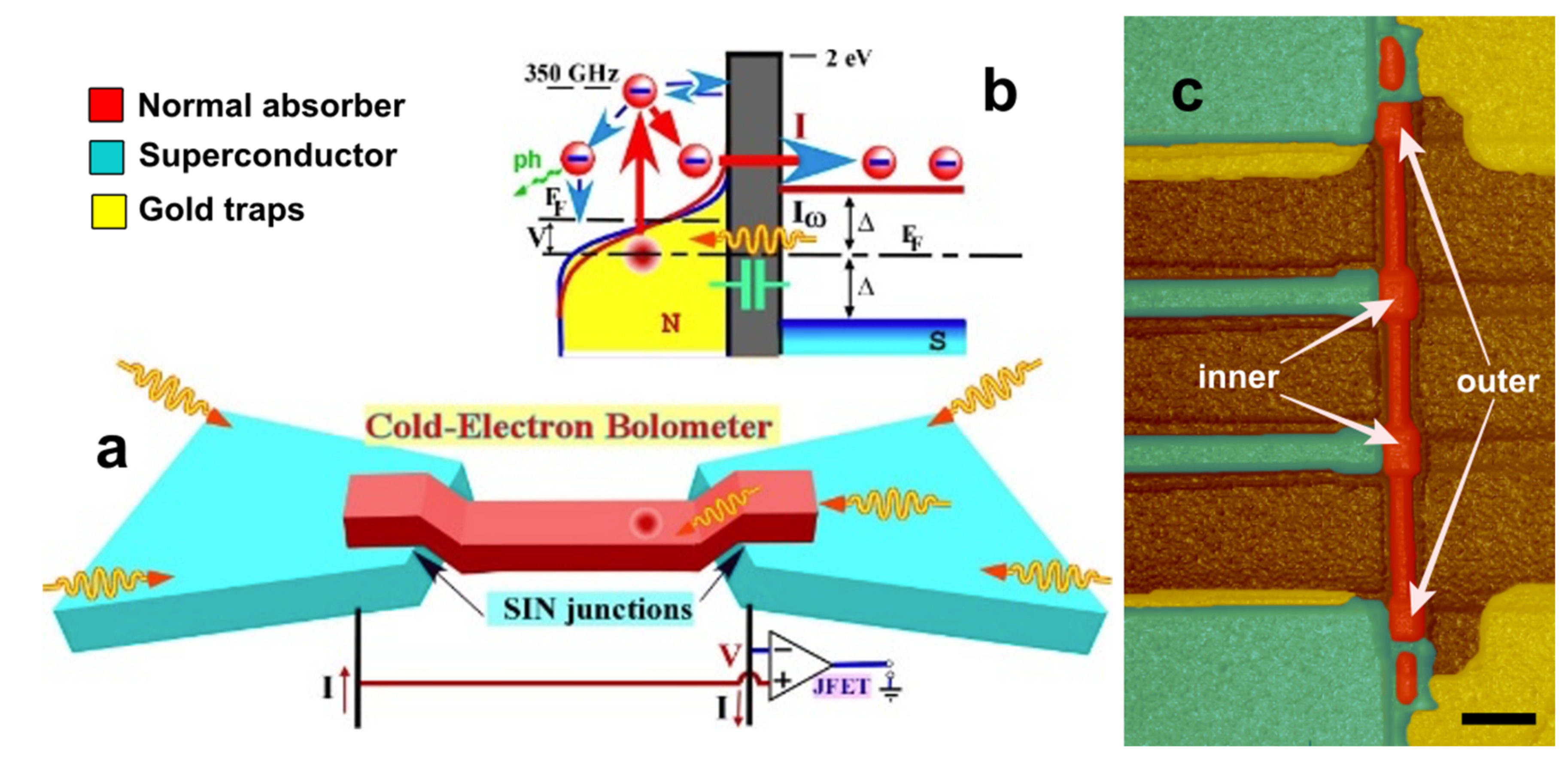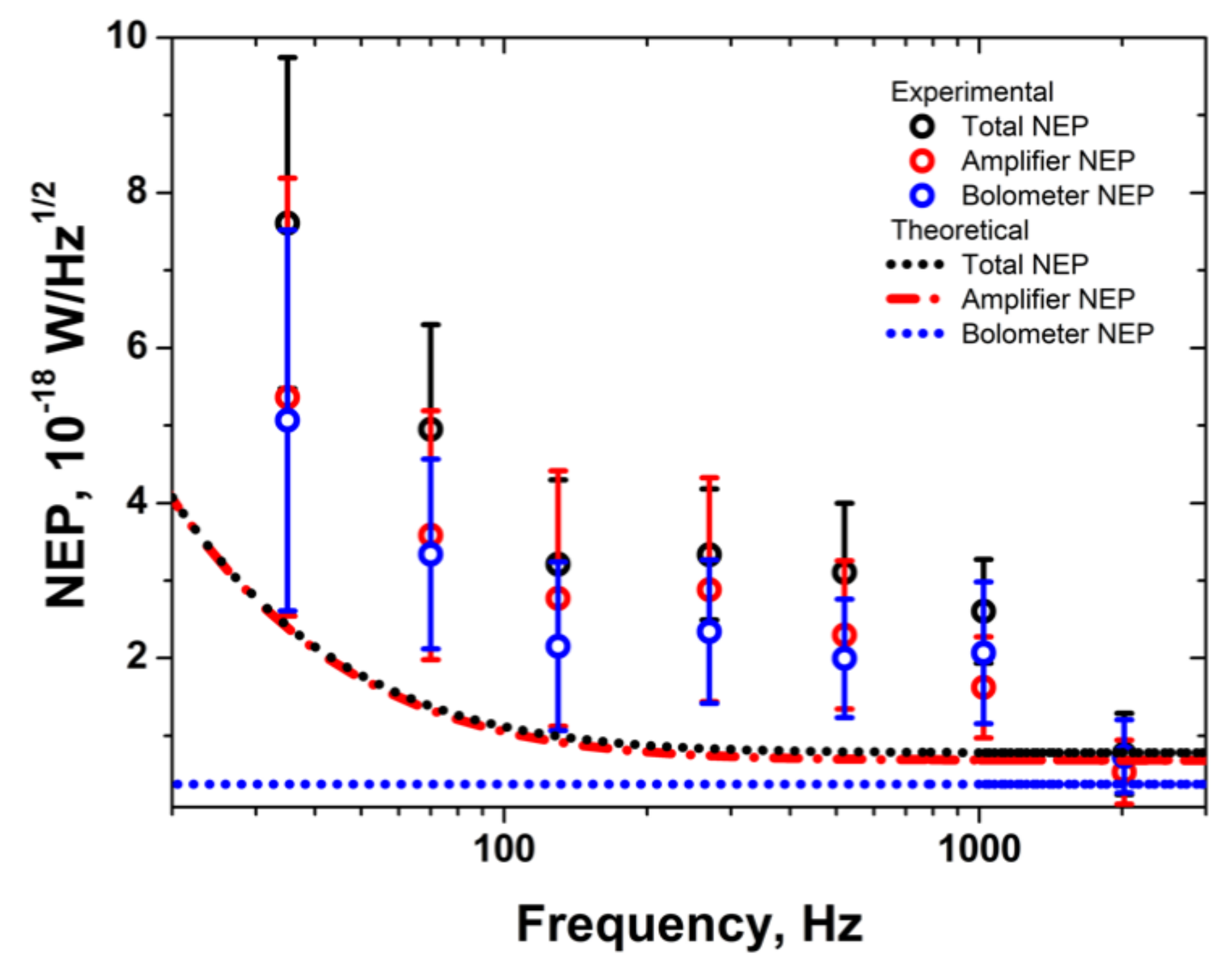Responsivity and Noise Equivalent Power of a Single Cold-Electron Bolometer
Abstract
1. Introduction
2. Materials and Methods
3. Results
3.1. The Single CEB Device
3.2. Responsivity
3.3. Noise Eqiuvalent Power
3.4. Time Constant
4. Discussion
5. Conclusions
Author Contributions
Funding
Institutional Review Board Statement
Informed Consent Statement
Data Availability Statement
Acknowledgments
Conflicts of Interest
References
- Glanz, J. A Second Hint of Symmetry Violation. Science 1998, 282, 2169–2171. [Google Scholar] [CrossRef]
- Seife, C. BREAKTHROUGH OF THE YEAR: Illuminating the Dark Universe. Science 2003, 302, 2038–2039. [Google Scholar] [CrossRef] [PubMed]
- Crittenden, R.; Davis, R.L.; Steinhardt, P.J. Polarization of the Microwave Background Due to Primordial Gravitational Waves. Astrophys. J. 1993, 417, L13. [Google Scholar] [CrossRef]
- Seljak, U.; Zaldarriaga, M. Signature of Gravity Waves in the Polarization of the Microwave Background. Phys. Rev. Lett. 1997, 78, 2054–2057. [Google Scholar] [CrossRef]
- Day, P.; Le Duc, H.G.; Dowell, C.D.; Lee, R.A.; Turner, A.; Zmuidzinas, J. Distributed Antenna-Coupled TES for FIR Detector Arrays. J. Low Temp. Phys. 2008, 151, 477–482. [Google Scholar] [CrossRef]
- Day, P.K.; Le Duc, H.G.; Mazin, B.A.; Vayonakis, A.; Zmuidzinas, J. A broadband superconducting detector suitable for use in large arrays. Nat. Cell Biol. 2003, 425, 817–821. [Google Scholar] [CrossRef] [PubMed]
- Kuzmin, L. Optimization of the Hot-Electron Bolometer for Space Astronomy. In The International Workshop on Superconducting Nano-Electronics Devices; Pekola, J., Ruggiero, B., Silvestrini, P., Eds.; Springer: Boston, MA, USA, 2002; pp. 145–154. [Google Scholar]
- Kuzmin, L. Ultimate cold-electron bolometer with strong electrothermal feedback. SPIE Astron. Telesc. Instrum. 2004, 5498, 349–361. [Google Scholar] [CrossRef]
- Salatino, M.; De Bernardis, P.; Kuzmin, L.S.; Mahashabde, S.; Masi, S. Sensitivity to Cosmic Rays of Cold Electron Bolometers for Space Applications. J. Low Temp. Phys. 2014, 176, 323–330. [Google Scholar] [CrossRef]
- Kuzmin, L.; Agulo, I.J.; Fominsky, M.; Savin, A.; Tarasov, M. Optimization of electron cooling by SIN tunnel junctions. Supercond. Sci. Technol. 2004, 17, S400–S405. [Google Scholar] [CrossRef]
- Kuzmin, L. An array of cold-electron bolometers with SIN tunnel junctions and JFET readout for cosmology instruments. J. Phys. Conf. Ser. 2008, 97, 6–12. [Google Scholar] [CrossRef]
- Tarasov, M.A.; Kuzmin, L.S.; Edelman, V.S.; Mahashabde, S.; De Bernardis, P. Optical Response of a Cold-Electron Bolometer Array Integrated in a 345-GHz Cross-Slot Antenna. IEEE Trans. Appl. Supercond. 2011, 21, 3635–3639. [Google Scholar] [CrossRef]
- Gordeeva, A.V.; Zbrozhek, V.O.; Pankratov, A.L.; Revin, L.S.; Shamporov, V.A.; Gunbina, A.A.; Kuzmin, L.S. Observation of photon noise by cold-electron bolometers. Appl. Phys. Lett. 2017, 110, 162603. [Google Scholar] [CrossRef]
- Kuzmin, L.S.; Pankratov, A.L.; Gordeeva, A.V.; Zbrozhek, V.O.; Shamporov, V.A.; Revin, L.S.; Masi, S.; de Bernardis, P. Pho-ton-noise-limited cold-electron bolometer based on strong electron self-cooling for high-performance cosmology missions. Nat. Commun. Phys. 2019, 2, 104. [Google Scholar]
- Anghel, D.-V.; Kuzmin, L. Capacitively coupled hot-electron nanobolometer as far-infrared photon counter. Appl. Phys. Lett. 2003, 82, 293–295. [Google Scholar] [CrossRef]
- Kuzmin, L.S. Cold-Electron Bolometer. In Bolometers; Perera, A.G.U., Ed.; IntechOpen: London, UK, 2012; ISBN 978-953-51-0235-9. [Google Scholar]
- Agulo, I.J.; Kuzmin, L.; Fominsky, M.; Tarasov, M. Effective electron microrefrigeration by superconductor–insulator–normal metal tunnel junctions with advanced geometry of electrodes and normal metal traps. Nanotechnology 2004, 15, S224–S228. [Google Scholar] [CrossRef]
- Golubev, D.S.; Kuzmin, L.S. Nonequilibrium theory of a hot-electron bolometer with normal metal-insulator-superconductor tunnel junction. J. Appl. Phys. 2001, 89, 6464–6472. [Google Scholar] [CrossRef]



Publisher’s Note: MDPI stays neutral with regard to jurisdictional claims in published maps and institutional affiliations. |
© 2021 by the authors. Licensee MDPI, Basel, Switzerland. This article is an open access article distributed under the terms and conditions of the Creative Commons Attribution (CC BY) license (https://creativecommons.org/licenses/by/4.0/).
Share and Cite
Agulo, I.J.; Kuzmin, L. Responsivity and Noise Equivalent Power of a Single Cold-Electron Bolometer. Appl. Sci. 2021, 11, 4608. https://doi.org/10.3390/app11104608
Agulo IJ, Kuzmin L. Responsivity and Noise Equivalent Power of a Single Cold-Electron Bolometer. Applied Sciences. 2021; 11(10):4608. https://doi.org/10.3390/app11104608
Chicago/Turabian StyleAgulo, Ian Jasper, and Leonid Kuzmin. 2021. "Responsivity and Noise Equivalent Power of a Single Cold-Electron Bolometer" Applied Sciences 11, no. 10: 4608. https://doi.org/10.3390/app11104608
APA StyleAgulo, I. J., & Kuzmin, L. (2021). Responsivity and Noise Equivalent Power of a Single Cold-Electron Bolometer. Applied Sciences, 11(10), 4608. https://doi.org/10.3390/app11104608






